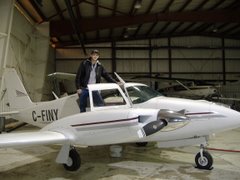I am SO glad to be back into multi-engine flying. Its just so much more fun. We started out with a briefing on the things we planned to cover - all the typical air work stuff like turns, steep turns, slow flight, approach to stall, etc. and then fired the ol' girl up and taxied out. The first take-off went ok, it was both fun and challenging to get back into the swing of a busy take-off roll and climb-out. The biggest error I made was getting distracted after we were airborne with retracting the landing gear and flaps and setting climb power and letting my airspeed decrease too much. Airspeed should always be maintained during the climb-out after takeoff. But that will come as I get more accustomed to the airplane.
Up at altitude most of the air work was a piece of cake, and most of the multi-engine emergency procedures came back to me fairly quickly as well. I was obviously no multi-engine master, but I think I did represent my experience fairly well and looked like someone who didn't have to be taught all over again how to fly a twin.
We went back to the airport for a couple circuits, and although my approach was fairly good, the first landing attempt was pretty ugly. This is no Cessna anymore! Actually the Navajo behaves very similarly to how the Twin Comanche behaves on landing, it just sits much higher off the ground. I think I overcompensated for the high stance and ended up flaring too high, didn't have enough power on into the flare and ended up stalling it onto the runway. Nothing too jolting, but still it was one of those "oh crap add power" moments just as we were touching down.
Unfortunately a few months ago back in the spring, the Company tried to hire a pilot for the Navajo, but unfortunately he couldn't really get the hang of the airplane and during training he put it down hard and did many thousands of dollars of damage to the landing gear. I think that is still in the back of everyone's mind and is still a bruise to the company wallet, so the pressure is on both for me, and for my training Captain not to let the same thing happen again.
My second approach I was feeling that pressure. In mind its acceptable to not grease your first attempt at landing a new aircraft, so there's really not a whole lot of pressure there as long as you don't panic and over-control and do something stupid. But the second attempt you had better have learned. I was feeling the pressure on final for our second landing. My approach was perfect - nice and stabilized, my target airspeed was pinned, and I had a good power setting and glideslope going in. Even still I had a moment where my heart started beating and I was thinking "Don't screw this up!". I actually don't remember when was the last time in my professional career that I felt the pressure like that. Luckily I did have the advantage of a perfectly calm day, and I managed to overcome any anxiety and make the touchdown a pretty good one (of course there is much room for mastery yet). The Captain seemed happy, so we taxied into the fuel pumps and shut down. He didn't say much about anything, which I interpret as meaning I did a good job, and I was fairly satisfied with my performance. You always have to be sparing with the praise when you're dealing with pilots, otherwise our heads swell and it makes it difficult to fit into the cockpit.
Ego's are a difficult thing to manage when two pilots are working together. Unfortunately I have almost zero experience working side-by-side with other pilots. My jobs prior to now have been single-pilot affairs, so I pretty much got to be the one and final authority in the airplane. If I made a small mistake, no one would notice and I wouldn't look stupid to anyone. But also I didn't have the advantage of spending mass amounts of time watching a more experienced pilot do his thing. All my experience up until now has been born out of personal lessons I've learned and experience from being Pilot-in-Command and I've had very little influence from watching more seasoned pilots. This is one thing I'm actually really looking forward to - getting to tag along as First Officer with a high-time pilot to see how he does things. Its also going to be a challenge as well though, because now there are two ego's in the cockpit, and a first officer has to walk a fine line between challenging the Captain's ego, and safely managing his human side (that can sometimes make mistakes) to contribute to a safer flight. Its going to be especially challenging because this is the first time the company is implementing two-crew SOPs (standard operating procedures) for the Navajo, so up until now my Captain has been accustomed to flying the airplane all by himself (as have I in the airplanes I've flown), so giving up a little bit of control and trusting the guy next to you is going to be a bit of a change for both of us.




Remember you have authority too. If you see a mistake. Say something.. More than likely you will be praised.
ReplyDelete